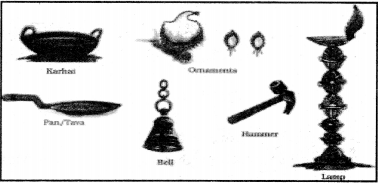Inside our Earth Class 7 Questions and Answers Geography Chapter 2
Class 7 Geography Chapter 2 NCERT Textbook Questions and Answers
Question 1.
Answer the following questions :
(i) What are the three layers of the earth?
Answer:
The three layers of the earth are :
- Crust
- Mantle
- Core
(ii) What is a rock?
Answer:
Rock is a hard material that makes up the earth’s crust. Various combinations of minerals made up hundreds of different types of rocks.
(iii) Name three types of rocks.
Answer:
The three types of rocks are :
- Igneous rocks
- Sedimentary rocks
- Metamorphic rocks
(iii) How are extrusive and intrusive rocks formed?
Answer:
Extrusive rocks:
When the molten lava comes on the earth’s surface, it rapidly cools down and become solid. Rocks formed in such a way on the crust are called extrusive igneous rocks.
Intrusive rocks:
Sometimes the molten magma cools down deep inside the earth’s crust. Solid rocks so formed are called intrusive igneous rocks.
(iv) What do you mean by a rock cycle?
Answer:
When one type of rock changes to another type under certain conditions in a cyclic manner, this process is known as rock cycle.
(v) What are the uses of rocks?
Answer:
Rocks are useful to us in the following ways:
The hard rocks are used for making roads, houses and buildings.
Some stones are used in games such as, seven stones (pitthoo) hop-scotch (stapu/kit kit), five stones (gitti), etc.
(vi) What are metamorphic rocks?
Answer:
The Greek word metamorphose means change of form. Metamorphic rocks change their original form without any disintegration. Igneous and sedimentary rocks undergo changes in their appearance under great heat and pressure. The new rocks formed are called metamorphic rocks. For example, clay changes into state and limestone into marble.
Question 2.
Tick the correct answer :
(i) The rock which is made up of motten magma is :
(a) Igneous
(b) Sedimentary
(c) Metamorphic
Answer:
(a) Igneous.
(ii) The innermost layer of the earth is :
(a) crust
(b) core
(c) Mantle
Answer:
(b) Core.
(iii) Gold, petroleum and coal are examples of :
(a) Rocks
(b) Minerals
(c) Fossils
Answer:
(b) Minerals
(iv) Rocks which contain fossils are :
(a) Sedimentary rocks
(b) Metamorphic rocks
(c) Igneous rocks
Answer:
(a) Sedimentary rocks,
(v) The thinnest layer of the earth is :
(a) Crust
(b) Mantle
(c) Core
Answer:
(a) Crust.
Question 3.
Match the following :
| (i) Core | (a) changes into slate |
| (ii) Minerals | (b) used for roads and buildings |
| (iii) Rocks | (c) made of silicon and alumina |
| (iv) Clay | (d) has definite chemical composition |
| (v) Sia! | (e) innermost layer |
Answer:
| (i) Core | (e) innermost layer |
| (ii) Minerals | (d) has definite chemical composition |
| (iii) Rocks | (b) used for roads and buildings |
| (iv) Clay | (a) changes into slate |
| (v) Sia! | (c) made of silicon and alumina |
Question 4.
Give reasons :
1. We cannot go to the centre of the earth.
2. Sedimentary rocks are formed from sediments.
3. Limestone is changed into marble.
Answer:
1. We cannot go to the centre of the earth because the core of the earth has very high temperature and pressure.
2. Sedimentary rocks are formed from sediments because the sediments are transported/ deposited by wind, water, etc. These loose sediments are compressed and hardened to form layers of rocks, which are known as sedimentary rocks.
3. Limestone (metamorphic rock) is changed into marble because igneous and sedimentary rocks change into metamorphic rocks under great heat and pressure.
Question 5.
For fun :
(a) What are the minerals most commonly used in the following objects?
(b) Identify some more objects made of different minerals.

Answer:
(a) The above materials can be made of the following :
(i) Iron, stainless steel
(ii) Brass
(iii) Copper
(iv) Aluminium
(v) Silver/Gold
(vi) Wood/iron
(vii) Glass/beads, etc.
(b) Almirah, cooler, glass, plates, frypan, etc.